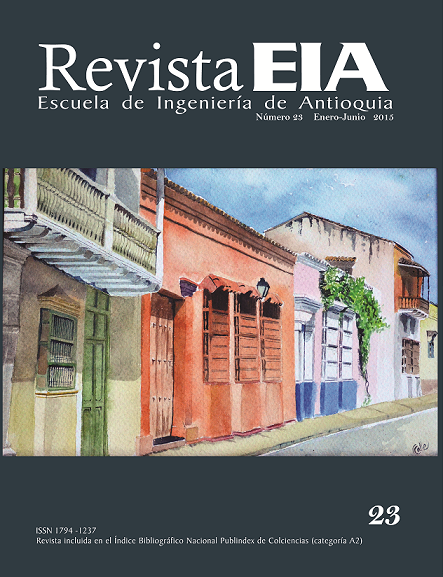COBERTURA GEOESPACIAL DE NODOS DE ACTIVIDAD PRIMARIA. ANÁLISIS DE LOS APORTES A LA SOSTENIBILIDAD URBANA MEDIANTE UN ESTUDIO DE ACCESIBILIDAD TERRITORIAL
COBERTURA GEOESPACIAL DE NODOS DE ACTIVIDAD PRIMARIA. ANÁLISIS DE LOS APORTES A LA SOSTENIBILIDAD URBANA MEDIANTE UN ESTUDIO DE ACCESIBILIDAD TERRITORIAL


This work is licensed under a Creative Commons Attribution-NonCommercial-NoDerivatives 4.0 International License.
Copyright statement
The authors exclusively assign to the Universidad EIA, with the power to assign to third parties, all the exploitation rights that derive from the works that are accepted for publication in the Revista EIA, as well as in any product derived from it and, in in particular, those of reproduction, distribution, public communication (including interactive making available) and transformation (including adaptation, modification and, where appropriate, translation), for all types of exploitation (by way of example and not limitation : in paper, electronic, online, computer or audiovisual format, as well as in any other format, even for promotional or advertising purposes and / or for the production of derivative products), for a worldwide territorial scope and for the entire duration of the rights provided for in the current published text of the Intellectual Property Law. This assignment will be made by the authors without the right to any type of remuneration or compensation.
Consequently, the author may not publish or disseminate the works that are selected for publication in the Revista EIA, neither totally nor partially, nor authorize their publication to third parties, without the prior express authorization, requested and granted in writing, from the Univeridad EIA.
Show authors biography
Resumen
Esta investigación aplica técnicas geoestadísticas con el fin de entender la relación existente entre las características operativas de la red de transporte de la ciudad de Manizales (Colombia) y la ubicación geoespacial de los llamados Nodos de Actividad Primaria (NAP). Los NAP son aquellos que suplen las principales necesidades de la comunidad influencian- do directamente las condiciones de sostenibilidad de una ciudad, incluyendo: salud, educación, recreación y seguridad. La investigación se soporta en la obtención de más de 18 millones de datos de GPS instalados en diferentes modos de transporte por un período de tiempo mayor a un año. Se determinan los tiempos medios de viaje que deben ser invertidos para alcanzar los NAP, los cuales son base para la obtención de las curvas isócronas, que a su vez permiten conocer las coberturas geoespaciales de las mismas en términos de población, área y número de viviendas. Se identifican las zonas de la ciudad que refieren algún tipo de deficiencia respecto a la cobertura de los NAP, dada su relación con los sistemas de transporte. Se exponen las bondades de la metodología y cómo ésta podría ser utilizada para definir programas de planificación urbana sostenible y áreas de influencia.
Abstract
We apply geostatistical techniques in order to assess the relationship between the operating characteristics offered by the urban transport network in the city of Manizales (Colombia) and the geospatial location of the Primary Activity Nodes (PAN). The PAN are those that supply vital community needs such as: Health, Education, Recreation and Safety. This research is built on a set of more than 18 million GPS data points, compiled throughout a period of one year. Average travel times to reach the PAN and geospatial coverages in regards to population and area, are calculated. Graphical results are presented, explaining the required travel times to reach a certain NAP, and performing quantitative comparisons across the geoespacial coverage thereof. We identify the areas of the city indicating deficient coverage of the NAP, in relationship to the urban transport systems. Finally, we describe the benefits of the methodology and offer it as an approach to optimize urban sustainable planning processes, and areas of influence.
Resumo
Esta pesquisa aplica técnicas de geoestatística para compreender a relação entre as características do funcionamen- to da rede de transportes da cidade de Manizales (Colômbia) e localização geoespacial dos chamados nodos de atividade primária (NAP). Os NAP são aqueles que satisfazem as necessidades primárias da comunidade influenciando diretamente as condições de sustentabilidade de uma cidade, incluindo: Saúde, Educação, Lazer e Segurança. A pesquisa é suportada na obtenção de mais de 18 milhões de dados de GPS instalados em diferentes modos de transporte, por um período superior a um ano. Determinam-se os tempos médios de viagem a ser investido para alcançar o NAP, que são a base para a obtenção de curvas isócronas, que por sua vez fornecem informações sobre coberturas geoespaciais para nós, em termos de popu- lação, área e número de habitações. São identificadas as Áreas da cidade que se relacionam com algum tipo de deficiência na cobertura do NAP, dada a sua relação com os sistemas de transportes. Os benefícios da metodologia são apresentados e como ele pode ser usado para definir os programas de planejamento urbano sustentável e áreas de influência.
Article visits 331 | PDF visits 190
